2024 November 2
Asteroid (247) Eukrate occults TYC 3778-00712-1 for 8.91 s from Gnosca.

2024 September 30
Asteroid (48153) 2001 FW172 occults UCAC4 302_270349 for 2.44 s from Fluminimaggiore (IT).

2024 September 17
Asteroid (137) Meliboea occults UCAC4 490-145158 for 9.95 s from Fluminimaggiore (IT).

2024 September 14
Asteroid (24471) 2000 SH313 occults UCAC4 584-129037 for 0.86 s from Fluminimaggiore (IT).

2024 September 05
Asteroid (308) Polyxo occults UCAC4 358-107131 for 11.2 s from Fluminimaggiore (IT).

2024 August 11
Asteroid (165650) 2001 HN36 occults UCAC4 603-112913 for 0.6 s from Gnosca.

2024 July 17
Asteroid (13345) 1998 SW132 occults UCAC4 415-131219 for 0.45 s from Gnosca.

2024 April 25
Asteroid (45611) 2000 DV54 occults TYC 6195-01419-1 for 0.50 s from Gnosca.
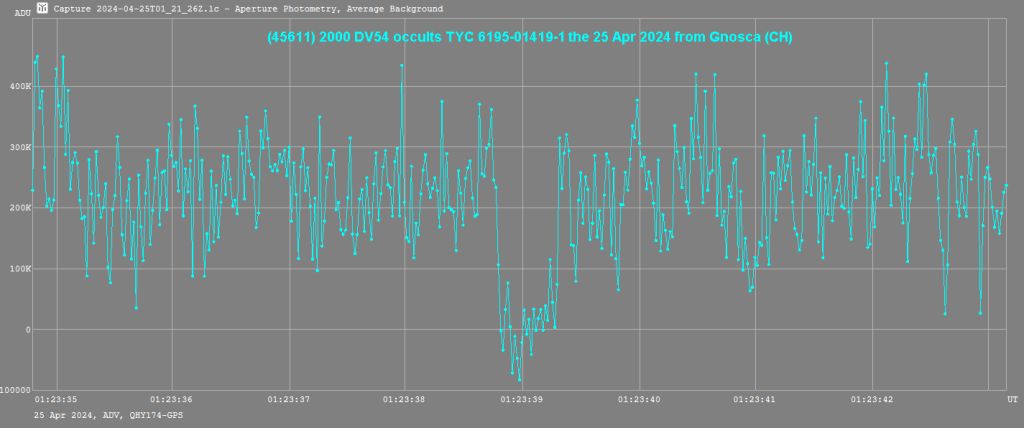
2024 April 18
Asteroid (1960) Guisan occults UCAC4 337-072852 for 1.65 s from Gnosca.

2024 April 12
Asteroid (248) Lameia occults UCAC4 522-045824 for 4.1 s from Locarno.

2024 April 12
Asteroid (599) Luisa occults UCAC4 644-038828 for 1.16 s from Locarno.

2024 April 12
Asteroid (4446) Carolyn occults UCAC4 392-122480 for 1.37 s from Gnosca.

2024 April 2
Asteroid (4280) Simonenko occults UCAC4 512-050185 for 0.64 s from Gnosca and for 0.86 s from Carasso.

2024 March 19
Asteroid (131) Vala occults UCAC4 567-044771 for 5.0 s from Gnosca and for 7.1 s from Mezzovico.

2024 March 16
Asteroid (11745) 1999 NH3 occults UCAC4 511-048273 for 0.75 s from Gnosca.
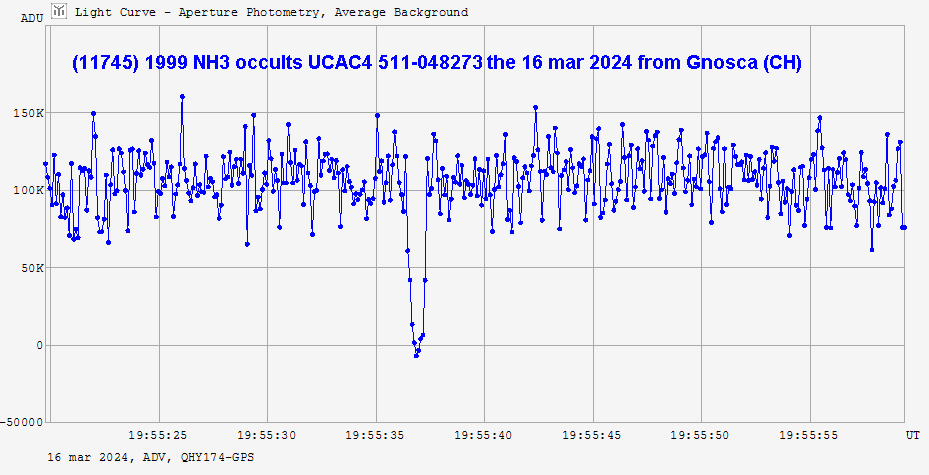
2024 February 5
Asteroid (738) Alagasta occults TYC 1325_00631_1 for 1.83 s from Gnosca and for 10.46 s from Mezzovico.

2024 February 2
Asteroid (491) Carina occults TYC 4784_02065_1 for 6.34 s from Gnosca and for 7.36 s from Verdabbio.

2024 January 28
Asteroid (16708) 1995 SP1 occults UCAC4 656-007871 for 0.90 s from Gnosca.

2024 January 28
Asteroid (2098) Zyskin occults TYC 6136_00213_1 for 0.654 s from Santa Maria Calanca.

2024 January 27
Asteroid (1420) Radcliffe occults UCAC4 558-024067 for 2.91 s from Gnosca.
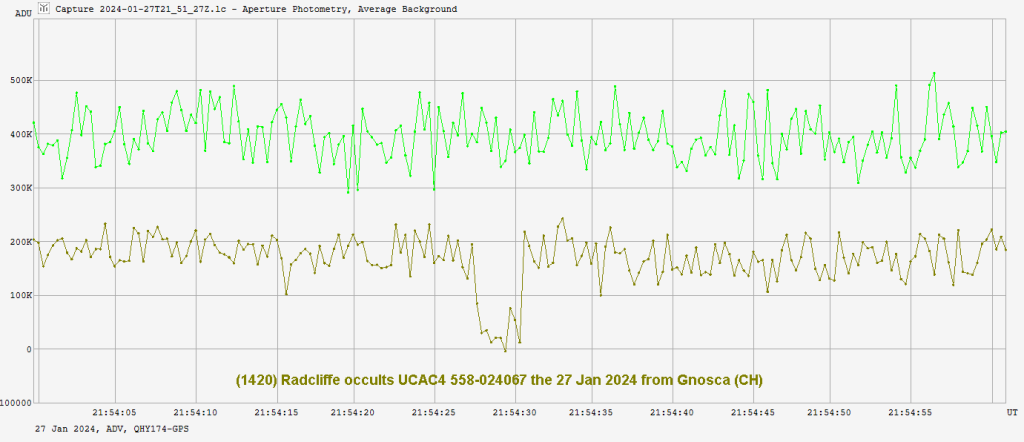
2024 January 25
Asteroid (217) Eudora occults UCAC4 489-051141 for 2.4 s from Gnosca.
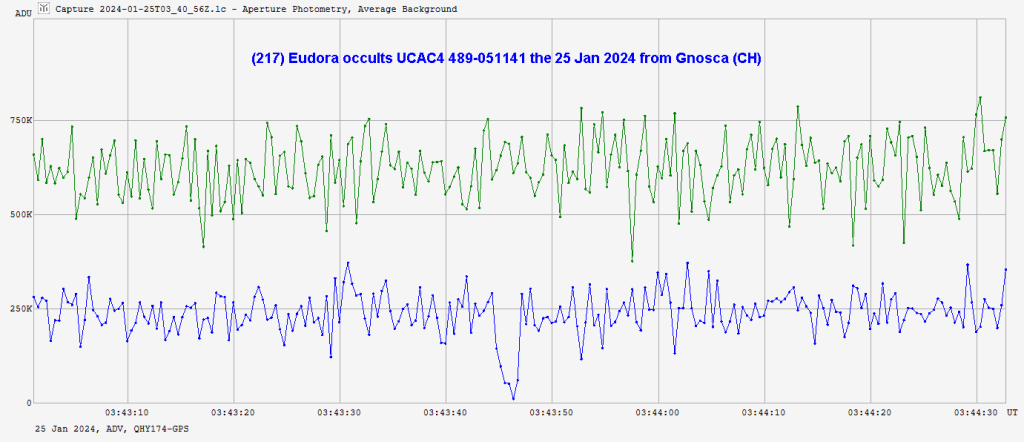
2024 January 24
Asteroid (1018) Arnolda occults UCAC4 551-003848 for 0.68 s from Gnosca.

2024 January 16
Asteroid (32950) 1996 CA1 occults UCAC4 731-039722 for 0.63 s from Gnosca.

2024 January 15
Asteroid (14569) 1998 QB32 occults TYC 2418-00347-1 for 1.63 s from Gnosca.

2024 January 13
Asteroid (510) Mabella occults UCAC4 483-043261 for 2.08 s from Gnosca.

2024 January 11
Asteroid (8389) 1993 FT37 occults UCAC4 550-027614 for 0.7 s from Gnosca.
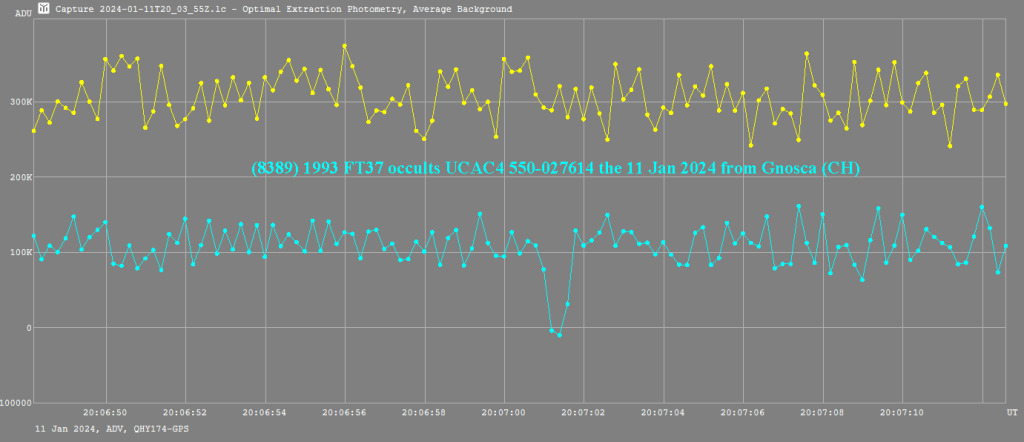
2023 December 25
Asteroid (10065) Greglisk occults UCAC4 530-028683 for 1.7 s from Gnosca.

2023 December 15
Asteroid (8325) Trigo-Rodriguez occults UCAC4 487-000892 for 2.0 s from Gnosca.

2023 December 12
Asteroid (319) Leona occults HIP 27989 (=alpha Orionis=Betelgeuse) for ~6 s from Cagliari (I).

2023 December 6
Asteroid (5295) Masayo occults UCAC4 574-034612 for 2.0 s from Gnosca.

2023 December 6
Asteroid (466) Tisiphone occults UCAC4 635-024942 for 2.22 s from Gnosca.

2023 December 5
Asteroid (140261) 2001 SJ263 occults TYC 2419-00928-1 for 0.80 s from Gnosca.

2023 December 4
Asteroid (740) Cantabia occults UCAC4 486-005508 for 7.0 s from Gnosca.

2023 December 3
Asteroid (3495) Colchagua occults UCAC4 518-004988 for 2.5 s from Gnosca.

2023 November 18
Asteroid (2414) Vibeke occults UCAC4 546-001436 for 4.13 s from Gnosca.

2023 October 12
Asteroid (412) Elisabetha occults UCAC4 459-005219 for 9.8 s from Seedorf (UR)
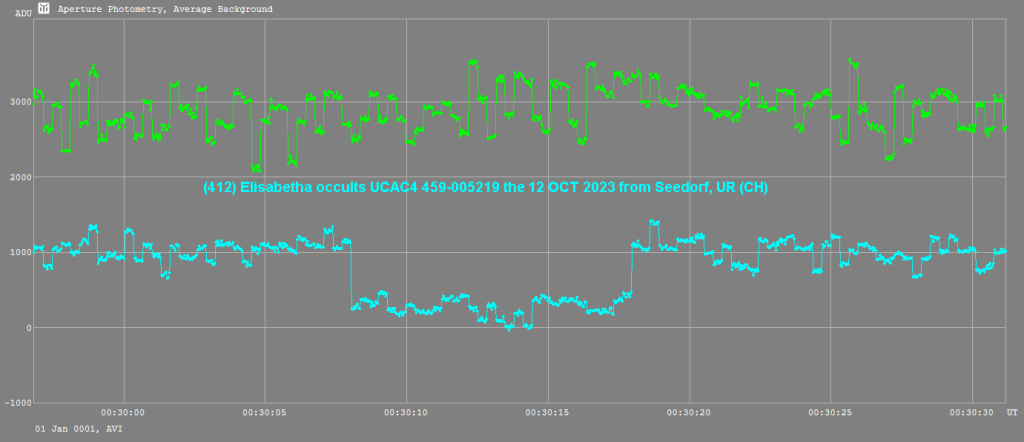
2023 October 10
Asteroid (21587) Christopynn occults UCAC4 511-037880 for 1.3 s from Gnosca
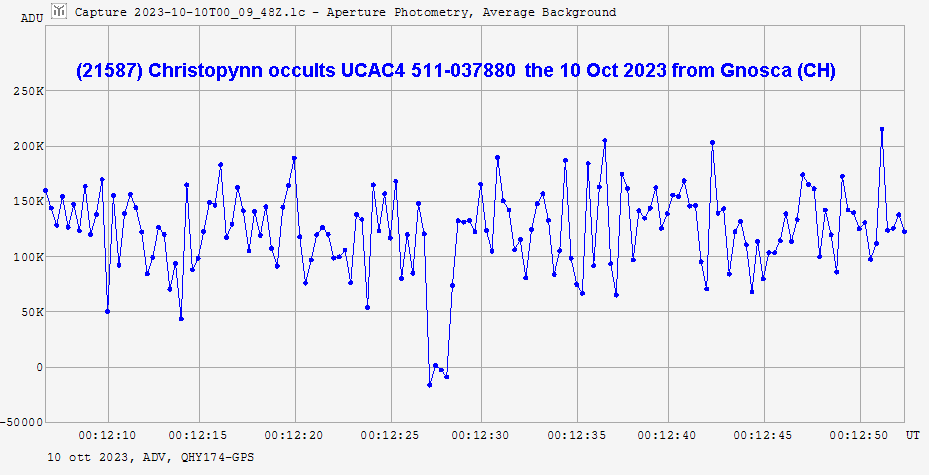
2023 September 11
Asteroid (16614) 1993 FS35 occults UCAC4 576-024303 for 0.32 s from Gnosca.

2023 September 8
Asteroid (1490) Limpopo occults UCAC4 502-141527 for 1.68 s from Bellinzona. The event was followed live with other eight persons.

2023 August 19
Asteroid (7102) Neilbone occults UCAC4 429-113086 for 2.1 s from Gnosca

2023 March 27
Asteroid (331) Etheridgea occults UCAC4 477-050079 for 5.2 s from Gnosca.
2023 March 25
Asteroid (6230) Fram occults UCAC4 562-033163 for 0.65 s from Gnosca.

2023 March 16
Asteroid (12392) 1994 WR2 occults UCAC4 608-036394 for 0.65 s from Gnosca.

2023 March 15
Asteroid (236) Honoria occulted UCAC4 527-015482 for 1.5 s from Gnosca.

2023 March 5
Asteroid (221) Eos occulted TYC 1393-00914-1 for 9.39 s from Gnosca.

2023 February 28
Asteroid (85) Io occulted UCAC4 455-047902 for 11.78 s from Gnosca.

2023 February 4
Asteroid (764) Gedania occulted UCAC4 520-037672 for 5.1 s from Gnosca.
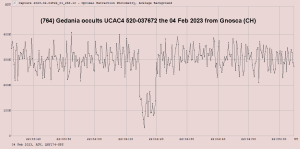
2023 February 1
Asteroid (95850) 2003 FA122 occulted UCAC4 479-009240 for 0.62 s from Gnosca.

2023 January 18
Asteroid (43152) 1999 XM115 occulted TYC 1335-00660-1 for 0.615 s from Gnosca.

2023 January 18
Asteroid (3981) Stodola occulted UCAC4 570-016272 for 3.0 s from Gnosca.

2023 January 11
Asteroid (263463) 2008 EP34 occulted TYC 1286-01127-1 for 0.3 s from Gnosca.

2022 December 16
Asteroid (24749) Grebel occulted UCAC4 429-043035 for 1.0 s from Gnosca.

2022 December 11
Jupiter trojan (624) Hektor occulted UCAC4 676-037147 for 3.5 s from mobile station Faido.

2022 December 10
Titania, the satellite of Uranus, occulted UCAC4 531-004984 for 73 s from Gnosca.

2022 December 5
Asteroid (8301) Haseyuji occulted UCAC4 541-014371 for 0.28 s from Gnosca.
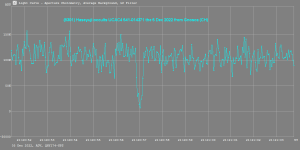
2022 November 23
Asteroid (121) Hermione occulted UCAC4 577-024884 for 13.3 s from Gnosca.

2022 November 22
Asteroid (4744) Rovereto probably occulted UCAC4 612-008956 for 1.6 s from Gnosca. The event is uncertain.

2022 October 25
Asteroid (1078) Mentha probably occulted UCAC4 550-043771 from Gnosca. The event is uncertain.

2022 September 11
Asteroid (59592) 1999 JW58 occulted UCAC4 479-129046 for 0.24 s and for 0.05 s from Gnosca.

2022 August 25
Asteroid (928) Hildrun occulted UCAC4 350-187717 for 5.4 s from Gnosca.

2022 August 25
Asteroid (20607) Vernazza probably occulted UCAC4 348-153318 for 1.0 s from Gnosca. Event is uncertain.

2022 July 15
Asteroid (339) Dorothea occulted UCAC4 410-122578 for 3.0 s from Gnosca.
2022 July 6
Asteroid (568) Cheruskia occulted UCAC4 425-108098 for 5.3 s from Gnosca.
2022 April 15
Asteroid (22) Kalliope occulted UCAC4 621-038470 for 4.8 s from Gnosca.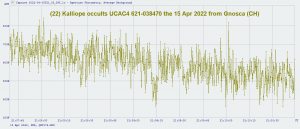
2022 April 9
Asteroid (1114) Lorraine occulted UCAC4 508-040537 for 3.5 s from Gnosca.
2022 April 5
Asteroid (10952) Vogelsberg occulted TYC 751-01393-1 for 0.35 s from Gnosca.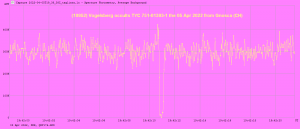
2022 March 26
Asteroid (19665) 1999 RT137 occulted UCAC4 590-037794 for 0.45 s from Gnosca.
2022 March 7
Asteroid (572) Rebekka occulted UCAC4 485-044691 for 3.5 s from Gnosca.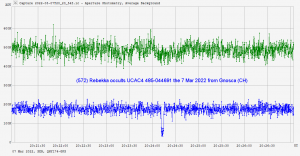
2022 February 11
Asteroid (930) Westphalia occulted UCAC4 558-049011 for 2.2 s from Gnosca.
2022 February 11
Asteroid (1171) Rusthawelia occulted UCAC4 539-047374 for 6.9 s from Gnosca.
2022 February 8
Comet 28P/Neujmin occulted UCAC4 638-016921 for ~ 1.7 s from Monte Ceneri.
2022 January 27
Asteroid (138) Tolosa occulted HIP 32194 for 3.3 s from Mendrisio.
2022 January 26
Asteroid (2204) Lyyli occulted UCAC4 395-009142 for 2.0 s from Gnosca.
2022 January 21
Asteroid (3701) Purkyne occulted UCAC4 561-032609 for 0.9 s from Gnosca.
2022 January 15
Asteroid (22721) 1998 ST50 occulted UCAC4 590-015078 for 1.2 s from Gnosca.
2022 January 10
Asteroid (2808) Belgrano occulted UCAC4 581-040294 for 1.7 s from Gnosca.
2022 January 06
Asteroid (754) Malabar occulted UCAC4 388-022610 for 5.0 s from Gnosca. The lightcurve shows a second drop lasting one integration time (ie. 150 ms).

2022 January 01
Asteroid (1039) Sonneberga occulted UCAC4 537-028151 for 1.2 s from Gnosca.
2021 December 30
Jupiter trojan (7641) Cteatus occulted the 7.1 mag HIP 4761 for ~ 0.5 s from Gnosca.
A nearby ( 2 m away) second telescope was observing simultaneously the event. The bigger telescope was observing with 10 ms integration time, the smaller with 20 ms. The two lightcurves show the same shapes of D and R (asymmetric respect to the vertical axis). At 20:16:52.77 UT it is to see a simultaneous drop of light (labeled A in red) probably caused by a feature located at the border of Cteatus.

2021 December 28
Asteroid (162) Laurentia occulted UCAC4 602-017692 for 3.7 s from Gnosca.
2021 December 17
Asteroid (19504) Vladalekseev occulted UCAC4 504-018812 for 0.35 s from Gnosca.
2021 December 16
Asteroid (12569) 1998 VC29 occulted UCAC4 520-007073 for 1.4 s from Gnosca.
2021 December 14
Asteroid (1030) Vitja occulted UCAC4 457-034000 for 4.0 s from Gnosca.
2021 December 12
Asteroid (16133) 1999 XC100 occulted UCAC4 571-038717 for 1.7 s from Gnosca.
2021 December 05
Asteroid (3671) Romanskaya occulted TYC 152-01576-1 for 2.05 s from Gnosca.
2021 November 30
Asteroid (1517) Beograd occulted UCAC4 577-016317 for 3.5 s from Gnosca.
2021 November 12
Asteroid (7574) 1989 WO1 probably occulted UCAC4 567-011544 for ~0.5 s from Gnosca. This observation is uncertain and happened after ~2 s the predicted event time and lasted 2 frames (1 frame = 0.200 s). The measured lightdrop was ~1 mag instead of the predicted drop of 2.4 mag R. The lightcurve is noisy. The sky was clear and steady.
2021 November 08
Asteroid (2184) Fujian probably occults UCAC4 571-012952 for 3.6 s from Gnosca. This observation is uncertain.

2021 November 07
Asteroid (626) Notburga occults UCAC4-760-020081 for 9.68 s from Gnosca.
2021 October 27
Asteroid (34167) 2000 QS30 occults UCAC4 472-005507 for ~ 0.3 s from Gnosca.

2021 October 19
Asteroid (40432) 1999 RW29 occults the 9.2 mag V star UCAC4 626-002760 for ~ 0.3 s from Gnosca.

2021 September 5
Asteroid (22) Kalliope #1 occults 2UCAC 40488211 for ~ 4 s from Fluminimaggiore (I).
2021 August 31
Asteroid (489) Comacina occults UCAC4 505-012002 during 2 integration frames for ~ 0.2 s from Gnosca.

2021 August 28
Asteroid (1032) Pafuri occults UCAC4 573-032880 for 1.18 s from Gnosca.
2021 August 22
Asteroid (49) Pales occults UCAC4 567-035481 for 4.3 s from Gnosca.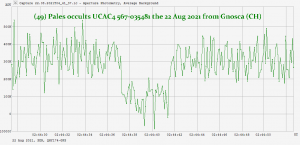
2021 August 15
Asteroid (219) Thusnelda occults UCAC4 543-005836 for ~ 0.7 s from Gnosca.
2021 August 7
Asteroid (2147) Kharadze maybe occults UCAC4 527-015350 during one integration frame, i.e. for 0.2 s from Gnosca.

2021 June 19
Asteroid (105) Artemis occults UCAC4 537-070312 for ~ 5 s from Gnosca.
2021 June 18
Jupiter trojan asteroid (2357) Phereclos occults TYC 6273-01107-1 for ~ 4 s from Gnosca.
2021 April 13
Asteroid (1628) Strobel occults UCAC4 444-070642 for 5 s from Gnosca. The lightcurve was normalized. This is the 100th positive occultation so far.
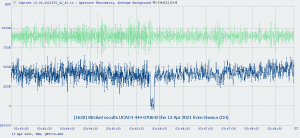
2021 March 24
Asteroid (1070) Tunica occults UCAC4 499-038086 for 3.0 s from Gnosca.
2021 February 11
Asteroid (4059) Balder occults UCAC4 502-041311 for 1.5 s from Gnosca.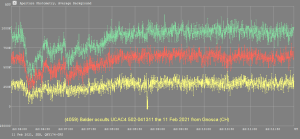
2021 January 15
Asteroid (7903) Albinoni occults TYC 769-01024-1 for 0.4 s from Gnosca.
2020 December 18
Asteroid (356) Liguria occults UCAC4 637-038898 for 15 s from Gnosca.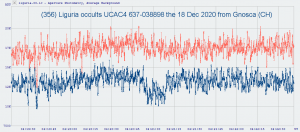
2020 November 21
Asteroid (401) Ottilia occults UCAC4 515-003101 for 7.9 s from Gnosca.
2020 November 14
Asteroid (275) Sapientia occults UCAC4 535-013994 for 9.5 s from Gnosca.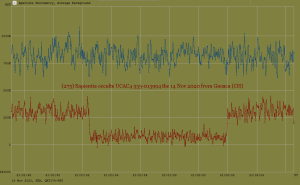
2020 November 6
Asteroid (69914) 1998 ST158 occults TYC 2425-00703-1 for 1.7 s from Gnosca.
2020 October 31
Asteroid (11945) Amsterdam occults TYC 30-00381-1 for 0.58 s from Gnosca.
2020 August 22
Asteroid (328) Gudrun occults TYC 6947-00591-1 for 5.68 s from Locarno.
2020 July 27
Asteroid (3664) Anneres occults UCAC4 350-164328 for 0.8 s.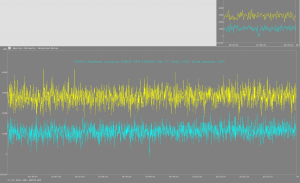
2020 July 27
Asteroid (91) Aegina occults TYC 0010-01080-1 for 24.59 from Gnosca and 24.9 s from Locarno.

2020 July 19
Asteroid (1646) Rosseland occults UCAC4 363-088756 for 1.62 s.

2020 June 27
Asteroid (336) Lacadiera occults TYC 5745-1897-1 for 9.95 s.
2020 June 06
Asteroid (2) Pallas occults UCAC4 561-089839 for 27.8 s.
2020 May 27
More than 2 years have passed after the last recorded Moon impact flash. A new probable one was captured the 27 May 2020 at 20:48:49 UT. (Lunarscan ® printscreen).

2020 April 11
Asteroid (667) Denise occults UCAC4 541-054062 for 5.0 s.
2020 February 18
Asteroid (393) Lampetia occults UCAC4-496-004715 for 5.1 s.
2020 February 11
Asteroid (22694) Tyndall occults UCAC4 656-025849 for 0.48 s.
2020 February 2
Asteroid (238) Hypatia occults UCAC4 481-021366 for 14 s from the remote site Arbedo.
2020 January 16
Asteroid (2058) Roka occults UCAC4 564-015416 for 2.9 s.
2020 January 6
Asteroid (6) Hebe occults TYC 0300-00301-1 for 7,44 s.
2019 December 26
Asteroid (3278) Behounek occulted UCAC4 394-057901 for 0,80 s.
2019 December 26
Asteroid (798) Ruth occulted UCAC4-508-025991 for 3,44 s.
2019 October 6
Asteroid (511) Davida occulted UCAC4 533-041969 for 12,6 s.
2019 August 14
Asteroid (163) Erigone occulted UCAC4-368-180084 for 3,8 s.
2019 March 22
Asteroid (260) Huberta occulted UCAC4 376-077090 for 18 s. The measured lightdrop was 0.7 mag.

2019 February 27
The uncertain occultation of UCAC4 500-012561 by the asteroid (14446) Kinkowan. The event lasted 0,08 s , i.e. one integration interval.

2019 February 25
Asteroid (3631) Sigyn occults UCAC4 501-012393 for 2,56 s.
2019 February 24
Asteroid (58) Concordia occulted UCAC4 543-024190 for 6,7 s.
2019 January 3
Asteroid (137) Meliboea occulted UCAC4 418-150499 for 1,92 s from Locarno.
2018 December 28
Asteroid (95) Arethusa occulted UCAC4-498-040974 for 7,98 s.
2018 December 24
Centaur (145451) 2005 RM43 occulted UCAC4 534-010144 for 19 s.
2018 December 21
Asteroid (326) Tamara occulted UCAC4-524-054132 for 1,92 s.
2018 November 29
Asteroid (539) Pamina occulted UCAC4 586-14797 for 3,28 s.
2018 November 28
Ateroid (1256) Normannia occulted 4UC 534-004727 for 6,4 s.
2018 October 4
Asteroid (2111) Tselina occulted TYC 0754-01369-1 for 1,48 s.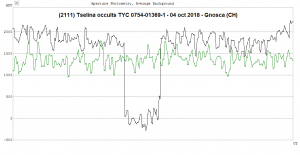
2018 September 8
At 02:58 UT the GNO_1 and GNO_2 cameras triggered and captured the longest meteor so far. Its duration was 23 s. Video1 and video2.
2018 April 21
Asteroid (130) Elektra occulted TYC 0408-00029-1 for 16,2 s from Gnosca, Bellinzona and Locarno.

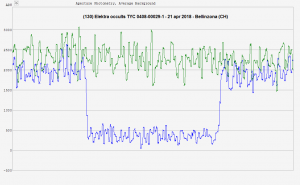

2018 April 17
Asteroid (4164) Shilov occulted 4U 411-52807 for 0,9 s.
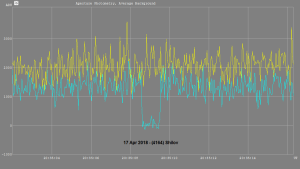
2018 March 22
Two new probable impact flashes on the Moon were recorded from Gnosca.
2018 March 14
Asteroid (4000) Hipparchus occulted 4UC 574-016894 for 0,6 s.
2018 February 27
Asteroid (466) Tisiphone occulted 2UCAC 41158475 for 11,8 s.

2018 January 28
The TNO body (84522) 2002 TC302 occulted 4UC 593-005847 for 103 s. This is the longest occultation recorded at Gnosca.

2017 December 22
Asteroid (1116) Catriona occulted 4UC 705-043934 for 4.5 s.
2017 December 20
Asteroid (62128) 2000 SO1 occulted 4UC 754-033794 for 1.1 s.
2017 November 30
Asteroid (50) Virginia occulted 4UC 543-025637 for 4.5 s.
2017 November 23
Asteroid (155) Scylla occulted 4UC 523-003622 for 4.4 s.
2017 November 19
Asteroid (38409) 1999 RK205 occulted 4UC 563-016974 for 1.0 s.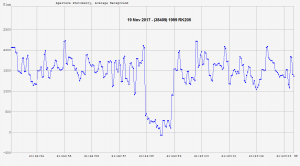
2017 October 23
Asteroid (154) Bertha occulted TYC 0638-00660-1 for 11.3 s.
2017 October 14
Asteroid (543) Charlotte occulted 4UC 611-020054 for 17.3 s.
2017 October 13
Asteroid (335) Roberta occulted 4UC 525-008744 for 19.8 s.

2017 October 06
Asteroid (173) Ino occulted TYC 5632-00827-1 for 4.36 s from the remote site Locarno.

2017 March 17
Asteroid (25846) 2000 EF93 probably occulted 4U 423-53132 during 2 integration times. The event is uncertain.

December 31 2016
Three flashes on the Moon (probably related to meteoroid impacts) were detected in 2016.
December 31 2016
Asteroid (1076) Viola occulted 4U 545-29824 for 1.2 s.
December 30 2016
Asteroid (754) Malabar occulted 2UCAC 27466644 for 10 s from the remote site Locarno.
December 11 2016
Asteroid (3970) Herran occulted 4U 501-1113 for 0.8 s.
November 29 2016
Asteroid (6983) Komatsusakyo occulted 4U 548-29774 for 0.6 s.
November 7 2016
Asteroid (2494) Inge occulted 2UCAC 43051828.
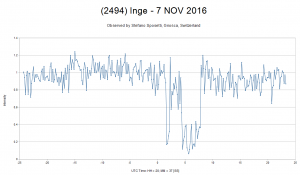
October 18 2016
Asteroid (43857)1993 VP2 suspectedly occulted 4U 582-5597 for 0.16 s from Gnosca. The event lasted 1 integration time.

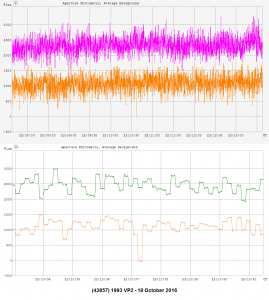
October 8 2016
Asteroid (67) Asia occulted TYC 5242-00199-1 for 7.1 s from Gnosca.
A 420 mm newtonian and a 280 mm SC telescope located 2.5 m apart observed the same lightcurve.

September 28 2016
Asteroid (36030) 1999NR59 occulted 1UT 457-443151 for 5.3 s from Gnosca.

September 24 2016
Asteroid (45) Eugenia occulted TYC 1298-00763-1 for 11 s from the remote location of San Bernardino. Observation made with Andrea Manna.

March 1 2016
Asteroid (7) Iris occulted 2UCAC 21800401 for 5.7 s from Gnosca
January 13 2016
Asteroid (76) Freia occulted 4UC 369-068390 for 5.1 s from Gnosca
December 2 2015
Asteroid (1114) Lorraine occulted UCAC4-493-006725 for 6.0 s from Gnosca.
October 31 2015
Asteroid (1075) Helina occulted 2UCAC 29389633 with a duration of 1.0 s from Gnosca.

August 20 2015
Asteroid (409) Aspasia occulted 1UT 571-046124 with a duration of 6.4 s from Gnosca.
April 9 2015
Asteroid (173) Ino occulted 2UCAC 37328537 with a duration of about 5 s from Gnosca and from Bellinzona.

March 12 2015
Asteroid (216) Kleopatra occulted HIP 54599 with a duration of 4.17 s from Bellinzona and 4.34 s from Lumino.

March 9 2015
Asteroid (51) Nemausa occulted 4UC382-077757 for about 7 s from Gnosca
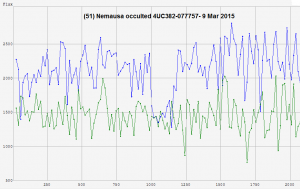
February 26 2015
Marco Iten recorded a very interesting flash of light on the Moon. With Raffaello Lena , we prepared a preliminary report of this rare event.
December 11 2014
Asteroid (465) Alekto occulted 2UCAC 40177689 with a duration of 7.97 s from Gnosca.

September 2 2014
Asteroid (924) Toni occulted 4UC 366-150084 with a duration of 17 s from remote site Bellinzona. The event was recorded with RA motors OFF.

August 23 2014
Asteroid (240) Vanadis occulted 4UC 335-172956 with a duration of 5.1 s from remote site Cadagno.
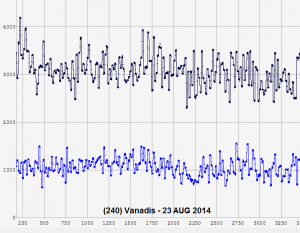
August 15 2014
Asteroid (4889) Praetorius occulted 4UC 442-123218 with a duration of 0.88 s from Gnosca. This is the shortest duration measured so far.

March 31 2014
Asteroid (442) Eichsfeldia occulted 2UCAC 37717864 with a duration of 15.3 s from Gnosca.

March 24 2014
Asteroid (2562) Chaliapin occulted TYC 1933-01727-1 with a duration of 2.4 s from Gnosca.

March 7 2014
Asteroid (9) Metis occulted HIP 78193 for several seconds from 4 stations: Bellinzona, Gnosca, Biasca and Semione.

March 8 2014
Asteroid (51) Nemausa occulted 4UC 514-024427 with a duration of 11.8 s from Gnosca.

February 6 2014
Asteroid (120) Lachesis occulted TYC 2406-00962-1 with a duration of 18.3 s from Gnosca.

January 15 2014
Asteroid (508) Princetonia occulted 2UCAC 45489325 with a duration of 8.6 s from Gnosca.

January 1 2014
Four probable meteoroid lunar impacts were detected in 2013. The number of the detected moon impacts reaches now 17.
September 9 2013
23 Meteors brighter than 0 mag were captured in less than 3 hours above Gnosca. The September Perseids showed a nice and unpredicted spectacle.
August 10 2013
Asteroid (268) Adorea occulted 4UC 355-195889 with a duration of 6.5 s from Gnosca.
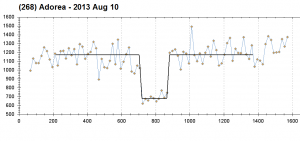
August 3 2013
Asteroid (407) Arachne occulted 4UC 319-088789 with a duration of 23 s from remote site Cadagno.

February 6 2013
Asteroid (31) Euphrosyne occulted 2UCAC 40191357 with a duration of 17.3 s from Gnosca and 6.7 s from Iragna. This observation was made with Jacopo Nannini.

January 26 2013
Asteroid (100) Ekate occulted TYC 0835-01282-1 with a 4.8 sec duration.

January 6 2013
Asteroid (87) Sylvia occulted TYC 1856-00745-1: 25.3 sec duration; 1.7 mag drop. Event captured with Andrea Manna from the remote site Condove.

January 1 2013
Marco Iten and me detected 5 possible meteoroid impacts on the Moon in the year 2013. The grand total is now 13.
November 24 2012
Asteroid (1309) Hyperborea occulted HIP 28558 with a 5 mag lightdrop.

October 8 2012
Asteroid (792) Metcalfia occulted 3UC200-115962. The event lasted 1.2 s.

March 26 2012
Asteroid (712) Boliviana occulted 3UC142-236470. The event lasted 4.5 s.

March 24 2012
Asteroid (686) Gersuind occulted 3UC147-126050. The event lasted 1.8 s.

February 21 2012
The Yaogan1 satellite is flashing quite brigthly (brighter than +1mag) with a period of 6.7s above Gnosca.
N. of flashes: 14 (some clouds prevented the sight)
Date: Feb 14 2012
Time: from 04:48:43.4 UT to 04:50:37.8 UT

February 17 2012
Quaoar occulted a 15.2 magV. A videocamera Watec 120N+ working in 10.24 s integration mode was used. The event lasted three integration intervals.

January 5 2012
Asteroid (198) Ampella occulted UCAC2 40143290 on Dec 29 2011. The event was captured from Gnosca and from the remote site Bigorio.

January 1 2012
Eight lunar impact candidates were detected so far (with Marco Iten) from 2 distant observatories. 6 other flashes (with the same characteristics of a meteoroid impact) were detected from only a single observatory.
September 20 2011
Asteroid (895) Helio occulted the 12.5 magV star TYC 2764-01038-1 on Sep 20 2011. The event lasted 3.2 s.

August 14 2011
A bright sporadic fireball illuminated the sky above Gnosca in the night of Aug 13 2011. A movie is here.
August 11 2011
The jupiter trojan (4709) Ennomos occulted the 9.2 mag star TYC 2224-01391-1. The duration of this event was 6.3 s. The event was captured from 2 nearby telescopes. Here a 19MB movie of the occultation.

May 03 2011
Asteroid (42) Isis occulted TYC 1934-01049-1, a 11.3 mag star in Gemini. The duration was about 2 s.

April 22 2011
Several flashes on the Moon were detected on the waxing Moon of April from Gnosca and from Gordola (Marco Iten’s observatory)
April 1 2011
Asteroid (554) Peraga occulted TYC 1343-01414-1. So far, this is the 11th positive occultation from Gnosca.

February 11 2011
A probable impact on the Moon.
January 25 2011
Asteroid (144)Vibilia occulted TYC 1228-00368-1. This event was captured from the observatory with video technique. A 8.56 s duration was measured. It’s the 10th positive occultation recorded. Curiously, the asteroid Vibilia was also observed from Gnosca in a positive 5.1 s double star occultation event the Sep 19 2006. Here a small 4MB AVI file of the event.

December 14 2010
Geminids above Ticino. The all sky camera captured about 270 geminids in the night of december 13/14.
December 10 2010
The brightness of the 12 mag star UCAC2 43911923 was dimmed for 6.8 s by the 14 mag minor planet (249) Ilse.

September 2 2010
The optical counterpart of the GRB100901A was easily detected from Gnosca. About 12h post-detection that point of light was shining between 17 and 18 mag.

September 1 2010
The 14 mag minor planet (1214) Richilde occulted a 10 magV star in the night of August 28 This image shows the CCD drift-scan of the registered event taken with the main 400 mm f/4 telescope of the observatory. The upper trace was only dark subtracted, the lower trace was electronically processed. The red line shows the intensity of the CCD trace.
The lower image shows the intensity variation (blue line) of the same event registerd simultaneously with a small C8 telescope and a WAT120N+ video camera with GPS time insertion. The red vertical line is placed where the beginning of the occultation occured. Yellow and green intensity lines belong to comparison stars.

May 22 2010
Flyby of the 20 m asteroid 2010KO10 in the night of May 22/23. This 30 s image shows the about 15 mag asteroid trail.
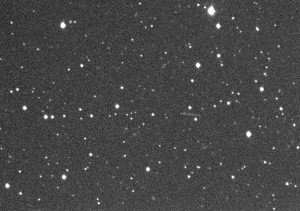
January 29 2010
In the night of Jan 27 2010 was observed the 7th positive occultation. (626) Notburga occulted 2UCAC 46562578. 5 mins and 12 sec before the predicted event, a first luminosity drop was detected. It’s origin is uncertain.

January 15 2010
The 13.3 mag asteroid (442) Eichsfeldia occulted a 12.7 mag star for about 4.8 s in the night of Jan 14 2010.

January 12 2010
The asteroid 2010AL30 captured thru clouds in the evening of Jan 11 2010. (45 images of 14 s each. Luminosity: 17.3 magR).

December 8 2009
The asteroid (52) Europa occulted a 10 mag star in the night of Dec 4 2009.

July 17 2009
Iridium 33 DEB flashes captured.
May 16 2009
Three unusual flashes were detected during the moon surface patrol of April 30.
March 18 2009
The asteroid 2009FH captured when it was at a distance of 320’000 km. See also this page from NASA-JPL.
March 4 2009
An animation of comet C/2007N3 (Lulin) spanning more than 6h.
February 24 2009
Another animation of comet C/2007N3 (Lulin) spanning about 5h.
February 18 2009
This animation of the comet C/2007N3 (Lulin) spans about 1 h and one can see the movement of the ion tail. See also this picture.
October 6 2008
The roughly 3 m size object 2008TC3 crossing the sky of the observatory imaged in this 10MB movie.
January 30 2008
The 250m Potentially Hazardous Asteroid 2007TU24 passed above the european nightsky. The January 28th its distance to the earth was 720’000 km. The day after its distance was 630’000km. Its speed was 9,5 km/s relative to the observer. I build up a first and a second animation of this near encounter.

January 1 2008
10 years of minor planet observing : 1998-2008. The total number of the discovered numbered minor planets at Gnosca is 109. 69th rank worldwide.
November 14 2007
A 21 mag positive detection of the optical counterpart of GRB071112C was done 4 hours and 10 mins after the BAT detection. Using FORS2 the VLT measured a redshift of z = 0.823.
October 27 2007
A composite image of the expanding dust of 17P Holmes.
October 25 2007
The outburts of the comet 17P/Holmes photographed between the clouds. With an angular diameter of 2.5 arcmin it is roughly 4 times larger than the angular diameter of Jupiter. Now the comet is a naked eye object in the Perseus constellation.
May 8 2007
Mr. Kazutami Namikoshi, director of the Japan Shiatsu College, and his wife Kyoko were visiting the Gnosca Observatory. The minor planet 61385 Namikoshi was discovered in Gnosca and was dedicated to the memory of Tokujiro Namikoshi (1905-2000) who was the founder of the worldknown Namikoshi Shiatsu therapy.
January 30 2007
Since 2002 ten positive optical GRB counterparts were detected. This time was the turn of GRB070125.
January 2 2007
The GRB060218 was captured from Gnosca the Feb 27 2006 and again the Dec 10 2006.
December 29 2006
The PHA asteroid 2006XG1 was imaged from Gnosca, just in the discovery day (Dec 11) and about 2 weeks after (Dec. 28). See also this link to see the positional measurements.
October 26 2006
The WMAP (Wilkinson Microwave Anisotropy Probe) satellite was imaged from Gnosca in the night of Oct 26 near the antisolar point.

See also this NASA site.
September 21 2006
Captured the transit of HD209458b.
September 20 2006
The occultation of the double star TYC 1879-02151-1 by the asteroid (144) Vibilia was positive. Its duration was 5.1 s. This is the 4th positive occultation recorded here in Gnosca.
August 1 2006
The asteroid (47164)Ticino, previously designed as 1999TX13, is now circling in the sky around the sun. The asteroid Ticino was discovered at Gnosca in 1999.
May 26 2006
At 16:28:30 UT, the Swift Burst Alert Telescope (BAT) triggered and located GRB 060526.
Observations at Gnosca begun at 20:50 UT, may 26, about 4.5 h later the Swift-BAT-trigger, under fair sky conditions. Imaging lasted until 23:40 UT. As a result a first stacked R-filtered image centred at 21:14 UT shows the OT at 18.8 mag with SNR = 9. (USNO A2.0 catalog). A second stacked R-filtered image centred at 23:20 UT shows the OT at the same magnitude and same SNR. The measured coordinates of the OT were: RA = 15h 31m 18.34s, decl = +00d 17m 04.7s (UCAC2 catalog). Observations continued from 20:40 UT to 22:30 UT, may 27 (about 27 h later the Swift BAT trigger), under good sky conditions. A stacked R-filtered image centred at 21:35 UT shows the OT at about 21 mag with SNR = 4. (USNO A2.0 catalog). Observations continued from 21:30 UT to 22:50 UT, may 29, under good but windy sky conditions. A stacked unfiltered image centred at 22:10 UT don’t show the OT anymore (limiting mag: about 21 at SNR = 3).
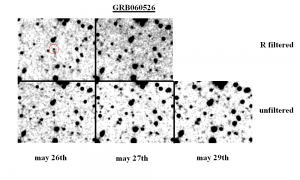
May 15 2006
The MACE2006 (Meeting on Asteroids and Comets in Europe) took place in the austrian capital Wien and ended the May 14 with this group photo.
March 25 2006
The Minor Planet Center accepted the proposal of the observatory to assign the name of the great theoretical physicist John A. Wheeler to the minor planet N. 31555 discovered the march 7 1999 at Gnosca. Here the citation:
John Wheeler (b. 1911) is one of the finest theoretical physicists.
From nuclear physics, to quantum theory, to relativity and gravitation,
Wheeler’s work has set the trajectory of research for half a century.
March 14 2006
The comet C/2006A1 Pojmanski in the morning sky of Gnosca.
February 19 2006
Two images show the shift of the north celestial pole between 2000 and 2006. In six years the apparent center of rotation of the stars has moved by about 2 minutes of arc. This is a manifestation of the drift of the earth rotational axis, also known under the name of precession of the equinoxes.

February 10 2006
The images on GRB060206 begun only 24h after the detection made by the Swift-BAT satellite. In this image one can see the optical counterpart at about 20 mag. A spectra made by the Lick Observatory showed a redshift of z = 4.05 for this OT.
February 7 2006
This article on Astronomy and Astrophysics describes and awards the photometric work made also at Gnosca on the double minor planets Tama, Berna, Frostia and Debussy.
January 24 2006
The night of Jan 24 at 15:55UT the HETE satellite detected a long gamma sky signal. At 19:47UT I could observe the same sky region with my telescope. A faint optical signal very near an annoying 15 mag star was to see. The day after I photographed the sky region anew: apparently the signal faded beyond my detection threshold. Here one can see an animation of the two pictures (of Jan 24 and 25).
These two images show the detection of the GRB060124 (the two white lines show the position of the optical counterpart of the GRB). The blue dots in the graph refer to the intensity of both stars in the picture of the january 24th. The red dots refer to the image of january 25th. From both curves one can see that the optical counterpart had faded.
January 21 2006
In the first hours of January 21 the asteroid 2006BA was traveling at about 750’000 km from the Earth. It was quite rapid and it was heading to the south. Its brightness was around the 17 mag. That night only the friend Peter Birtwhistle of the Great Shefford Observatory (obs code J95) and I from Gnosca (obs code 143) were observing 2006BA. Curiously Peter was shooting CCD pictures exactly at the same moment as I did.
Here the astrometry of two contemporary observations(to the tenth of a second):
K06B00A C2006 01 21.01788207 28 30.93 +00 56 21.5 16.8 R J95
K06B00A C2006 01 21.01788307 28 16.00 +00 58 00.6 16.7 R 143
In the left image I show these two positions. The Great Shefford Observatory (J95) is located in Great Britain and is at the North-West from Gnosca (143): therefore the position of the asteroid is more South-East from the position of Gnosca. Between these two positions I could measure about 4 arcminutes, i.e. about 1/8 of the Moon angular diameter. In the right image one can see the original picture of 2006BA taken from Gnosca.

Some hours later 2006BA was transiting at 500’000 km from the earth orbit. This object is not classified as PHA (Potentially Hazardous Asteroid) because it has a too small estimated diameter (roughly 15 m). The positional measurements from Gnosca were the last. No one additional observatory photographed 2006BA.
January 8 2006
The satellite Giove-A, the pioneer of the european fleet of GPS satellite system, was captured above Gnosca the Jan 8 2006. This image shows the faint trace of the satellite transiting at a distance of 23’000 km.
